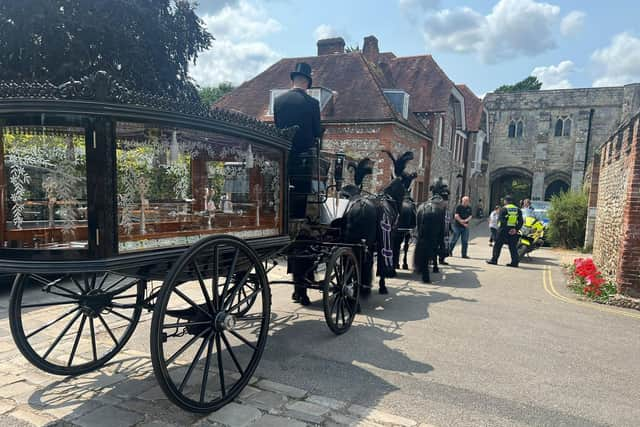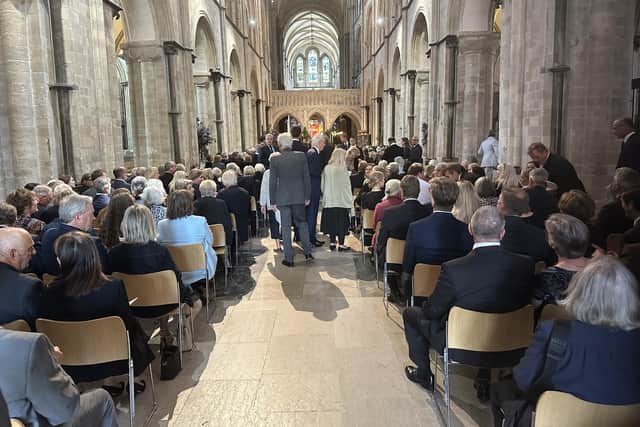Chichester's cathedral bells mark funeral of the inspirational Susan, Duchess of Richmond and Gordon
and live on Freeview channel 276
She died peacefully with her family present, on Tuesday, June 13. She was 90 years old.
The recurring theme at the service held at Chichester Cathedral was the duchess’ kindness, charisma and love of animals. Speaking in a eulogy, her son Charles Richmond touched frequently on all three, saying she “was always striving to do the right thing, for the right selfless reasons".
Advertisement
Hide AdAdvertisement
Hide AdAlongside her devotion to organic farming, contributions to dressage, and her love of her family, the current Duke of Richmond spoke of his mother’s charity work and her deep concern for the vulnerable people of the world.


"She became the absolute champion of the less fortunate,” he said. “What we will all remember most was her extraordinary generosity of spirit.”
Alongside the eulogy, members of the family read prayers and poetry devoted to the Duchess’ memory, and members of the public were invited to participate in hymns.
At four o’clock, after a recital of thine be the glory, The Duchess’ wicker coffin was carried out by the procession and drawn from the cathedral via West Street by horse and carriage.
Advertisement
Hide AdAdvertisement
Hide AdAfter the service, members of the public were invited to Goodwood House for tea. Those without a car were offered return transport between Goodwood and West Street. At the reception, collections took place for each of the charities of which the Duchess served as patron: Compassion in World Farming, The Roberts Centre, CancerWise, the British Hen Welfare Trust and Stonepillow.


Susan, Duchess of Richmond and Gordon, born on 26th July 1932. She was the daughter of Colonel Cecil Edward Montague Grenville-Grey and Louise Monica Morrison-Bell.
During World War II, Susan lived as a small child with her grandparents, the Morrison-Bells at the Close in Tetbury. Her father was fighting in the North African Campaign, and he and her mother lived in Egypt. This separation from her parents had a formative effect on her unusual devotion anddedication as a mother
In 1947 she met Charles Henry Gordon Lennox, Earl of March and Kinrara, who was her brother Wilfred’s best friend at Eton, and in 1951 she married Charles at Holy Trinity Brompton Road.
In 1952 she gave birth to their first child Ellinor.
Advertisement
Hide AdAdvertisement
Hide AdThe following year, Susan met Edith Buxton, when out for walk with the baby. This chance meeting ended up with her inviting Edith home for tea, and would go on to have a huge impact on her life. Edith was the daughter of CT Stud, the famous missionary, and wife of Alfred Buxton, whom she married in the Congo in 1917. Edith had a lasting influence on Susan and through Edith and her family and friends, Charles and Susan became deeply involved in Capricorn, the society set up by David Sterling, as a multi-racial pressure group. “We hold that all men despite their varying talents are equal in dignity before God and have a common duty towards one another. We hold that the differences between men, whether of creed or colour, are honourable difference.”
Charles became the treasurer of Capricorn and they both played a big part in the organisation, becoming more and more committed to the future of Africa. Charles went on to found the highly regarded periodical Africa Confidential.
In 1955 Susan gave birth to her second child, Charles Henry. This was a difficult time health wise and after the birth she became very unwell with
pre-eclampsia and went on to suffer post-natal depression, developing severe agoraphobia. Her own journey meant that she became increasinglyknowledgeable about childcare and was a great exponent of Bowlby and his thinking. The relationship between mother and child was something which was a consistent thread throughout her life. She would go on to say “one of my main concerns is the effect of techniques they use at childbirth on the emotional development of mother and child. Also, the importance of the relationship between them in the first few weeks”.
Advertisement
Hide AdAdvertisement
Hide AdThe couple moved to Rugby, so they could both study at the William Temple college which was an institution committed to spreading Christianityinto industry and the workplace.
In 1960, World Refugee Year, Susan took on the care of the Mattai family from Albania. Part of her life-long commitment and relentless support formarginalised people. The couple decided to adopt the first of two half-African children. Maria was fostered from the Church of England Children’s Society aged 6 months. This caused a massive furore, with Susan being chased down the street by the press. Maria was very unwell and experienced an extremely traumatic first 6 months of her life. Susan remarked on how shocked she was on her first visit, seeing all the children lined up with seemingly so little hope. They both felt that this was something they could help with and take a public stand on, which they courageously did.
She believed that love would triumph over everything. Maria’s health rapidly improved and she was soon a quickly accepted member of the family and sister to Ellinor and Charles.
In 1962 Naomi arrived, a smiley, happy baby who brought something very special to the family.
Advertisement
Hide AdAdvertisement
Hide AdThroughout this period and on through the 60s, Susan’s health continued to decline and she was introduced to the ground-breaking physician/nutritionist, Dr Latto. He immediately put her on a diet of wholefood, vegetables, and fruit. This was considered very whacky at thetime, but Susan fully embraced it bringing up the family on wholemeal bread, brown rice, live yoghurt and one day a month eating apples only. Thisin turn radically improved her health and she became an evangelist for natural food, an early member of the Soil Association and supporter of all things to do with animal welfare. “It was partly that I was horrified by the standard of animal welfare. Also, I got ill and went to see a brilliantman, Dr Latto, who told me about the effects of chemicals on the body. He put me on a simple diet of wholemeal bread, raw vegetables, nomeat, not much dairy – and told me I’d be fine in six months. When I had small children,” she added, “I wanted them to be fed properly.”In 1967 she went on to have another child, Louisa, without any sign of pre-eclampsia.
The next year, Susan and Charles decided to take on Goodwood - the House and Estate, and began the process of renovating and restoring it all so the family could live there. Since the War, the House had only been opened up once or twice a year for the horseracing in July and motor racing at Easter. The 9th Duke and Duchess never really lived at Goodwood following World War II, the House having been a hospital during that time.
The budget was £100,000 to spend on the House, and having been unable to persuade the National Trust to take it on, they decided to give themselves a couple of years to see if they could make a go of it, so they moved in with their five children in. They made a huge success of it, bringing the place back to life and making it relevant to a modern world. They were a uniquely modern couple embracing a post-War modernist Britain.
Passionate about horses since a child, Susan had started to ride again when the family had moved to Goodwood. She soon developed a particular love of dressage, a little-known sport in the UK at the time, and, because of this enthusiasm, she started holding her own dressage competitions atGoodwood.
Advertisement
Hide AdAdvertisement
Hide AdThis enterprise soon grew and twenty-one international dressage competitions were held at Goodwood from 1973 to 1993. Susan wasintegral in helping to persuade the Germans to bring their top dressage horses to Goodwood from the beginning, which gave the British an insightinto top-class dressage.
The Duchess was key to the development of British dressage. Through the hosting of international dressage competitions at Goodwood, dressage was transformed in Britain, growing from a sport the British found difficult to understand to the country’s fastest growing equestrian activity and one inwhich Britain has gone on to win team and individual gold medals in recent Olympics. She was president of British Dressage from 2007-2012.
In 1994 the 10th Duke and Duchess of Richmond retired and handed over the running of Goodwood to their son, Charles. Susan’s passion movedmore to driving horses than riding them and she continued to be as engaged as ever with the Estate and all her charity commitments -Patron of Compassion in World Farming, Stonepillow, British Hen Welfare, as well as close associations with Mercy Ships, Greenpeace, Roberts Centre, CancerWise, Brent Lodge Sanctuary, Samaritan’s Friends, West London Action for Children and West Sussex Cat andDog Rescue.
She was also instrumental in making Goodwood Home Farm completely organic. The catalyst that inspired the Duchess’s thinkingabout how the Estate ought to be farmed was a book, Silent Spring by Rachel Carson, first published in 1962. Documenting the detrimental effects on the environment of the indiscriminate use of pesticides, Carson’s book launched the shift of opinion away from intensive industrial farming, and towards today’s understanding that traditional methods might produce more sustainable farms and better-quality food.
Advertisement
Hide AdAdvertisement
Hide Ad“The transformation to the countryside that comes with this kind of farming was equally speedy. The difference in the hedgerows was very quick,” Susan, the Duchess recalls. “The birds, the wildflowers, the quiet on the farm. The animals are so peaceful – they look at you and don’t react.” It was all very different during her childhood, when the impact of intensive industrial farming was beginning to become apparent. And yet this isn’t simply an issue of animal welfare. “The animals’ meat tastes better when they haven’t been stressed and are looked after properly,” she argued.She was a devoted grandmother to 13 grandchildren and 4 great- grandchildren.Duchess Susan died at her home, Carnés Seat, at Goodwood on Tuesday, June 13.